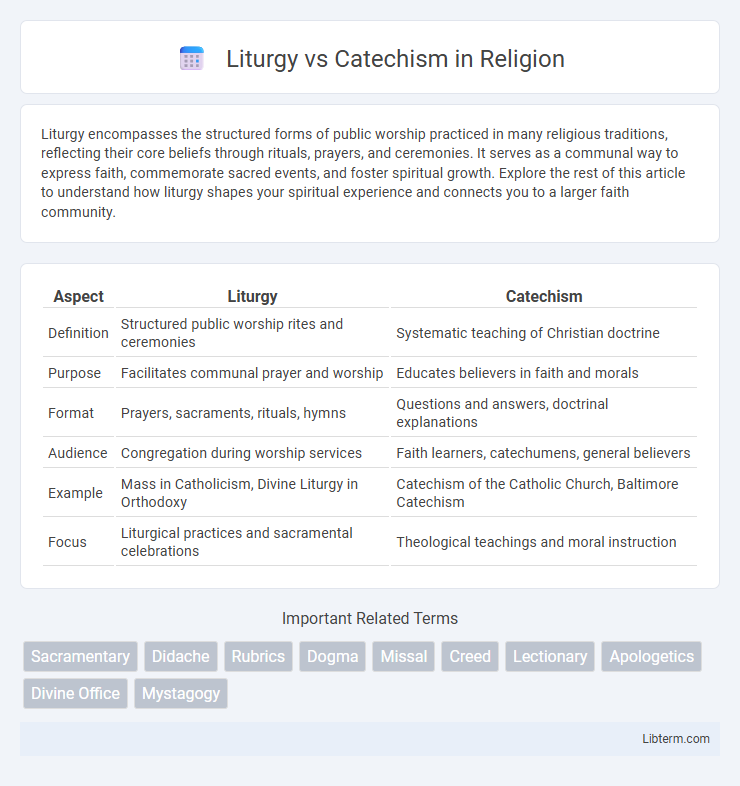Liturgy encompasses the structured forms of public worship practiced in many religious traditions, reflecting their core beliefs through rituals, prayers, and ceremonies. It serves as a communal way to express faith, commemorate sacred events, and foster spiritual growth. Explore the rest of this article to understand how liturgy shapes your spiritual experience and connects you to a larger faith community.
Table of Comparison
| Aspect | Liturgy | Catechism |
|---|---|---|
| Definition | Structured public worship rites and ceremonies | Systematic teaching of Christian doctrine |
| Purpose | Facilitates communal prayer and worship | Educates believers in faith and morals |
| Format | Prayers, sacraments, rituals, hymns | Questions and answers, doctrinal explanations |
| Audience | Congregation during worship services | Faith learners, catechumens, general believers |
| Example | Mass in Catholicism, Divine Liturgy in Orthodoxy | Catechism of the Catholic Church, Baltimore Catechism |
| Focus | Liturgical practices and sacramental celebrations | Theological teachings and moral instruction |
Understanding Liturgy: Definition and Purpose
Liturgy refers to the structured form of public worship practiced within religious traditions, designed to facilitate communal participation in sacred rituals and ceremonies. Its purpose is to express and reinforce faith through symbolic actions, prayers, and readings that connect believers to divine mystery and spiritual heritage. Understanding liturgy helps deepen appreciation for its role in fostering spiritual unity and guiding the faithful in worship and doctrinal expression.
What is Catechism? Core Principles Explained
Catechism is a structured method of religious instruction that explains the core beliefs, doctrines, and moral teachings of the Christian faith. It serves as a fundamental educational tool for both children and adults, outlining essential principles such as the Apostles' Creed, the Ten Commandments, and the sacraments. Unlike liturgy, which centers on public worship and ritual practices, catechism focuses on systematic doctrinal formation and personal faith understanding.
Historical Roots: Liturgy and Catechism in Christian Tradition
Liturgy and Catechism both have deep historical roots in Christian tradition, with liturgy tracing back to early communal worship practices as recorded in the New Testament and shaped by Jewish synagogue rites. Catechism developed later as a systematic teaching tool, formalized in the early Church to instruct converts and young believers in foundational Christian doctrines. Together, they represent the dual pillars of Christian life: worship through liturgy and doctrinal education through catechism.
Key Differences Between Liturgy and Catechism
Liturgy refers to the structured, communal worship practices and rituals performed in religious services, emphasizing prayer, sacraments, and collective participation. Catechism involves systematic religious instruction and education, focusing on teaching core doctrines, beliefs, and moral principles through question-and-answer formats or lessons. Key differences lie in liturgy's experiential worship setting versus catechism's didactic approach to religious knowledge and formation.
The Role of Liturgy in Worship
Liturgy plays a central role in worship by structuring communal prayers, rituals, and the celebration of sacraments that connect believers with the divine and the Church's tradition. It provides a consistent framework for expressing faith, fostering spiritual unity, and deepening the understanding of theological truths through embodied practice. Unlike catechism, which focuses on doctrinal instruction and teaching, liturgy emphasizes active participation and experiential encounter with sacred mysteries.
Catechism’s Role in Faith Formation
Catechism serves as a fundamental tool in faith formation by systematically teaching the core doctrines, moral principles, and sacramental understanding integral to Christianity. Unlike liturgy, which emphasizes communal worship and ritual practice, catechism provides structured education that deepens personal knowledge and strengthens doctrinal belief. This educational process empowers individuals to internalize and live out their faith with clarity and conviction.
How Liturgy and Catechism Intersect
Liturgy and Catechism intersect in their roles of conveying and reinforcing core Christian beliefs through distinct yet complementary methods: liturgy expresses faith through ritual and communal worship, creating a living experience of doctrine, while catechism systematically teaches these doctrinal truths using structured instruction and memorization. Both serve as essential tools for faith formation, with liturgy providing a practical embodiment of the teachings articulated in catechisms, enabling believers to internalize and celebrate doctrine collectively. This synergy deepens spiritual understanding by merging intellectual comprehension with experiential participation, fostering a holistic approach to religious education and devotion.
Common Misconceptions: Liturgy vs Catechism
Liturgy and catechism are often confused, with many assuming liturgy solely refers to worship services while catechism is only religious instruction. In reality, liturgy encompasses the structured rituals and prayers central to communal worship, deeply rooted in tradition and scripture. Catechism systematically teaches the core doctrines and moral teachings of the faith, serving as an educational tool to nurture understanding and personal belief.
Liturgy and Catechism in Modern Church Life
Liturgy in modern church life serves as a communal expression of faith, uniting congregations through structured worship, rituals, and sacraments that embody theological truths and spiritual experience. Catechism functions as an educational framework, providing doctrinal instruction and moral guidance essential for individual faith formation and the transmission of church teachings across generations. Both elements are integral; liturgy fosters participation and unity in worship, while catechism ensures a deep understanding of core Christian beliefs in contemporary religious practice.
Choosing the Right Focus: Guidance for Churches and Believers
Choosing the right focus between liturgy and catechism depends on a church's mission to balance worship experience with doctrinal education. Liturgy provides a structured form of worship that fosters communal participation and spiritual rhythm, while catechism emphasizes systematic teaching of core Christian doctrines for faith formation. Churches and believers should evaluate their congregation's needs for worship enrichment or theological grounding to effectively nurture faith and spiritual growth.
Liturgy Infographic

 libterm.com
libterm.com